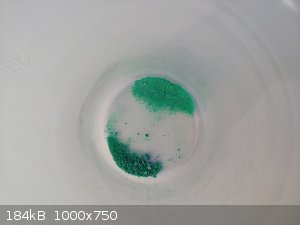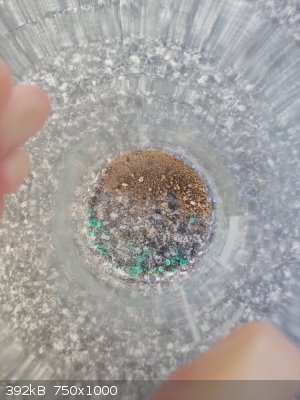
subskune - 20-4-2020 at 09:22
I destilled some old pyridine today and saw the temp was a bit low, so I thought it is probably wet. I put some dry MgSO4 in and a few hours in I
wanted to test for water.
I picked some CuSO4 pentahydrate which has a nice light blue color and drove off the water until it was white.
I let it cool and added some of the pyridine destillate. The CuSO4 turned navy blue immediately. However at this point I thought CuSO4 gone wet in a
weired way and I wanted to dry it again.
I heated the beaker on the hotplate and to my surprise it turned green. Further heating turned it brown.
I did some research and now know that CuSO4 forms a complex with pyridine, responsible for the navy blue color of the CuSO4. (still don't know if it
is wet )
)
But what happened during heating? What is the green and brown stuff?
Pics of green and brown stuff:


DraconicAcid - 20-4-2020 at 09:32
Pyridine, like ammonia, forms complex ions with many transition metals. I would expect the blue to be [Cu(py)4](2+) ions. The green is probably a
[Cu(py)2](2+) complex ion (also coordinated with sulphate? I don't know); the brown may be an oxide or more pyridine-poor complex.
subskune - 20-4-2020 at 10:15
Thanks a lot! I was really surprised as I thought a fancy reaction is going on...
DraconicAcid - 20-4-2020 at 10:28
I'm actually surprised at how much the green and blue stuff look like copper(II) chloride (hydrated and anhydrous, respectively).

 )
)